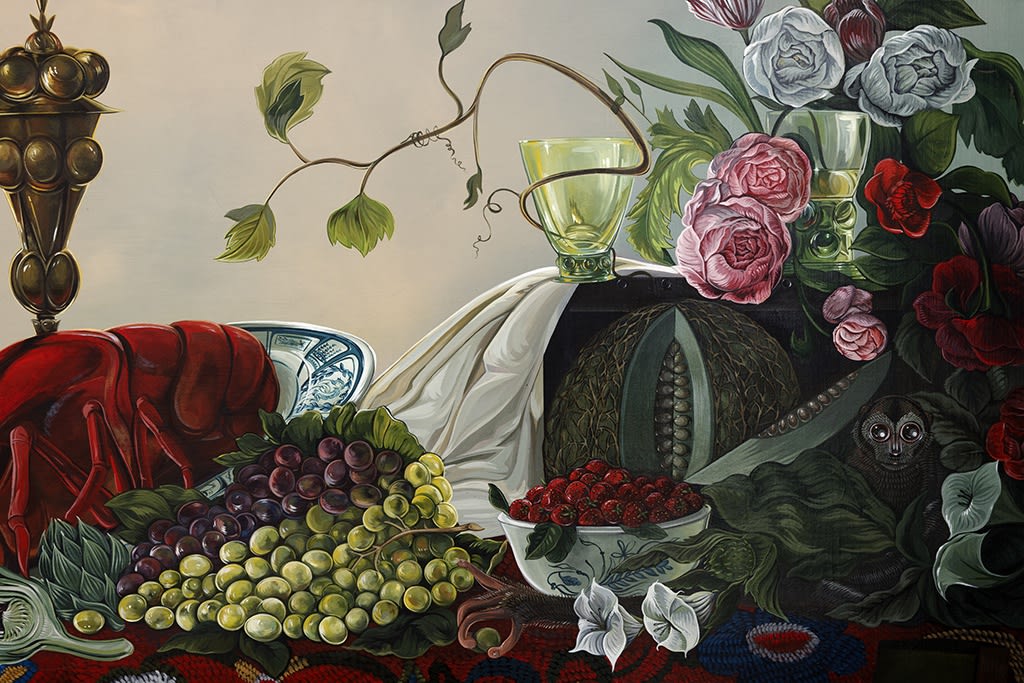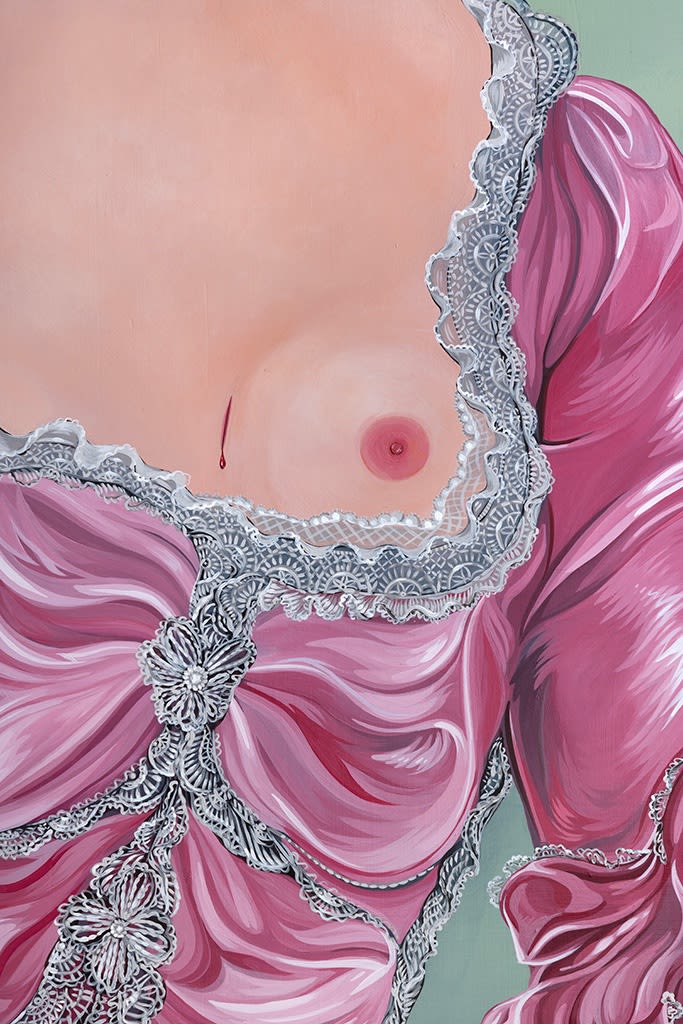Brooklyn-based artist Sabrina Bockler has a utilitarian view of love. Maybe not in her personal life, but in the way women have had to use love and its institutions to get a leg up in the world. Poison, daggers, drugs, and potions feature prominently in the artist’s newest solo exhibition Coquette at Hashimoto Contemporary NYC. Her newest series of paintings offer high-drama narratives about affection, objectified bodies, and how creatures deemed “helpless” can create their own agency—and chaos.
Before her solo exhibition opened, Sabrina spoke with Hashimoto Contemporary’s Katherine Hamilton about major themes in this new body of work and what’s behind these heavily symbolic works of art.
Katherine Hamilton: I’m wondering about the evolution of your paintings. Your earlier work was flatter, creating tensions by positioning the viewer and the background space on the same visual plane. But the works in Coquette have a lot of depth to them—each painstaking detail creates a world of materials and characters who can interact in space. How do you continue to manipulate visual space on the canvas?
Sabrina Bockler: I think the work has matured in a very organic way. My earlier paintings often featured static scenes where the source of tension was in the impossible compositions and suspended subject matter. Since then, I’ve shifted towards a more theatrical and dramatic aesthetic, emphasizing depth and dimensionality. My paintings, both past and present, have an off-kilter and sometimes unsettling dynamic, but now with added breathing room.
How do you create drama now?
My more recent works are centered around action, mischief, and performance. One of the more significant evolutions is the grounding of my subjects, almost as if they're trying to touch reality—well, my reality, which has its own rules.
I focus on color depth, richness, and, as you mentioned, painstaking detail. By zooming in on intricate elements while simultaneously zooming out to capture the broader scene, I want to enhance the overall visual impact of my work. Every tiny detail contributes to the narrative tapestry, allowing the audience to discover new nuances long after their first encounter. It feels more immersive and dynamic that way.
You mentioned the story of Madame de Montespan—The Affair of Poisons—as a main source of influence for this body of work. When did you first hear this story?
I came across The Affair of Poisons while binging various Art History docu-series on YouTube. It was a story that hit all the themes I was exploring for this show. It read like a soap opera with its allegations of widespread poisonings, black magic, and satanic rituals among the French aristocracy. Madame de Montespan was accused of using poison to maintain her position at court and eliminate her rivals. It was just another unfortunate example of misogyny and hysteria being weaponized against a woman rising beyond her social standing.
Were there any other stories you encountered during your research on love and antiquity that are folded into the work?
The story of Venus and Adonis is one of my favorites because it emphasizes themes of mortality, loss, and the fleeting nature of beauty, setting it apart from other myths that focus more on Venus’s divine attributes and romantic escapades with other gods. Adonis, a mortal, tragically dies. Venus transforms his blood into the anemone flower as a tribute to their love. I really love that part—the return to the earth.

Animals also feature quite often in your paintings as symbols of status, power, or excess wealth. But the animals in this series are also participants and protagonists—I’m thinking about the hallucinating monkey in Hungry Hearts as a symbol of “the perilous consequences of indulgence,” and of course the adorable Bichon Frisé who is a stand-in for the goddess Venus. Can you say more about the role of animals in your work?
Well, I love animals. Featuring them in my work feels very natural to me. I want to portray the animals with a sense of agency, as if they have interior lives within the paintings. They're aware of being observed and often play into or against the viewer's expectations. They make for great agents of chaos and occupy the space in a way that no person could.
My process typically follows a “build as you go” style. Sometimes, a piece starts with a specific animal protagonist in mind, and the rest of the scene evolves to support it, as in Venus in Furs. Other times, animals play a supporting role, injecting life and movement into the painting.
The animals are also vehicles for humor and social commentary in my work. There’s a Stepford wife quality to purebred dogs that I play up in Venus in Furs. My Bichon Venus, with her perfectly fluffed and coiffed hair and her modest attempts to cover her engorged nipples, represents the absurdity surrounding the objectification and policing of women’s bodies.

Speaking of portrayals of women, I want to ask about The Alchemist and its coded symbolism: the dagger in the love potion, the cut above her breast to symbolize the agony of unrequited love, the rooster as a symbol of unwavering determination.
The Alchemist is one of my favorite pieces to discuss. There are lots of little Easter eggs but its intended message is a bit more obvious than some of my other paintings. I make an effort not to spoon-feed the audience, preferring instead to make more subtle nods to themes and hidden meanings. The dagger, the Spanish Fly (a common love potion ingredient that’s actually poisonous), and the rooster in the sitter’s hand symbolize a woman’s determination in the pursuit of her intended lover. These elements, including the exposed breast, add to the sense of desperation and determination.

I can think of more than a few examples of hypocrisy in historical religious paintings. Many of the models who posed as the Virgin Mary or other religious figures were often prostitutes or women of apparently less than virtuous standing. I want to dispel the historical narrative that categorized women as either Madonna or whore, which only marginalizes women who did not fit neatly into either category.
Lately, I’ve been listening to podcasts on the origins of witch hunts. It’s terrifying how quickly the frenzy spread and how it became a tool for personal gain. It’s also unsurprising that the majority of those accused of witchcraft were unmarried or elderly women, often widows, and frequently from marginalized groups. Marriage to a man was, quite literally, a lifeline for women, offering their only chance to elevate their social standing. It’s no wonder that tales of women and love potions, intertwined with witchcraft, were so prevalent—it was often a desperate means of survival in a society that offered few alternatives.
I really love that description; I take pride in being a trickster! There’s something interesting that happens when you blur the line between reality and illusion. Given the hyper-detailed nature of my pieces, there’s a lot of room to hide little moments of mischief and hidden meaning. Someone once described my work to me as similar to topographical plans. I can’t say that I disagree; from a technical standpoint, my work takes shape through many flat layers and textures until it forms.
The paintings in Coquette represent the first time I introduced human forms into the scenes. They exude a sense of grandeur; I intended for them to be imposing, giant, almost god-like beings. Their proportions are distorted, and their identities are concealed; I make their limbs prominent, using them to facilitate the action rather than being central focal points. Their rendering diverges from other elements within the works: human bodies are scrubbed smooth, almost doll-like, creating a sense of displacement as if they're intruding upon the scene.

That’s so interesting, because I feel like the exhibition’s title, Coquette, is a human phenomenon. I was thinking about the fashion trend derived from “Lolita style,” a modernized version of Rococo style, though maybe more the Sophia Coppola version of Marie Antoinette than the young Queen of France.
Ah, Marie Antoinette is another woman who is historically misunderstood and misrepresented. Your first impression was definitely on point. Coquette, in essence, refers to a flirtatious woman, one who enjoys attracting and manipulating others’ affections for her own amusement or advantage. The term can carry both positive and negative connotations, depending on the context and the observer’s perspective.
The title draws inspiration from the Rococo era, a period that celebrated femininity across all genders. When I first landed on the title, it resonated with the bittersweet essence of the series—each piece encapsulates a flirtatious and playful energy, with hidden layers of meaning and symbolism. A double edge sword.
Sabrina Bockler’s solo exhibition Coquette is on view at Hashimoto Contemporary NYC through July 20th.

